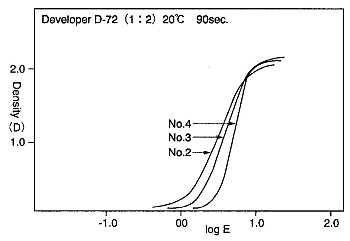 NEW SEAGULL RP
NEW SEAGULL RP
RP Paper
New Seagull RP is protected top and bottom by thin polyethylene (Resin
Protected). It is a high-sensitivity, jet black tone, general-use enlarging
paper.
From brilliant highlights to deep blacks, it has a rich range of tones.
Since processing agents do not penetrate into the paper, wash times are
dramatically shortened,
making it a high-efficiency product. The surface of the product has
a high degree of smoothness and there is virtually no dimensional distortion,
making it an easy-to-use paper.
Safelight
For general-use enlargers with yellow-green filters, 15W bulbs should
be used and the safelight should be at least one meter from the enlarger.
New Seagull RP is a veryhigh-sensitive paper and should not
be exposed more than 10 minutes. Be careful with prints after they have
been exposed.
Exposure
To raise processing efficiency, the sensitivity of New Seagull RP
has been raised to a very high level. The maximum level of sensitivity
gets lower as the grade number rises; #2, #3, and #4 have progressively
lower maximum sensitivity levels. #3 is about 70% of #2 in sensitivity
level. #4 is about 50% of #3 in sensitivity level. For most printing paper,
the density of the negative begins to fall from grades #3 and #4 and in
most cases cannot be raised much by increased exposure.
Sensitivity and gradient
| Grade |
ISO Speed |
ISO Range |
| No.2 |
P640 |
R110 |
| No.3 |
P400 |
R90 |
| No.4 |
P320 |
R70 |
Standard processing conditions
| Process |
Processing temperature |
Processing time |
| Development |
20+_ 0.5 C |
60~90 sec. |
| Stop bath |
15~25 C |
5~15 sec. |
| Fixing |
15~25 C |
3~5 min. |
| Washing |
15~25 C |
5~10 min. |
| Drying |
60~70 C |
30~60 sec. |
Developer
For New Seagull RP paper, it is possible to use almost all commercially
available developers or use standard formulations (D-72, etc.) without
changing the performance of the product.
Stop bath
For the stop bath, a solution of 1 .5% of glacial acetic acid is used.
| Time 15 to 30 seconds. |
| Water |
1 liter |
| Glacial acetic acid |
15 ml |
Fixer
Prepared fixer is recommended but, if you are preparing your own fixer,
either use an acid hardening fixer containing sodium thiosulfate (hypo)
or a rapid fixer containing ammonium thiosulfate. To make sure the prints
will develop uniformly and not be affected by contaminants in the developer,
the prints should be shaken in the developer. Keep the total fixing time
to ten minutes or less. If the fixing time is too long, there is a risk
that the tone balance will degrade.
Washing
The washing process can be finished in about five minutes by washing
in water while stirring. The stirring should not be to strong since the
corners of the prints may be damaged. If the washing is continued for too
long a time, the surface of the prints may become rough.
Drying
Drying is carried out using a hair dryer. It is also possible to dry
the prints naturally if they can be placed in a location where there is
sufficient air circulation.
Ferro-type dryers cannot be used.
High-temperature processing conditions
New Seagull RP has the properties which make it well-suited for high-speed
processing.
| Process |
Processing temperature |
Processing time |
| Development |
30+_ 0.5 C |
30 sec. |
| Fixing |
30+_ 0.5 C |
30 sec. |
| Washing |
- |
60 sec. |
| Drying |
50~60 C |
- |
Types of paper
| Type |
Base paper |
Weight |
Texture |
Tint |
Image tone |
Grade |
| F |
RP paper |
Medium |
Glossy, smooth |
White |
Jet black |
2~4 |
| R |
RP paper |
Medium |
Luster, smooth |
White |
Jet black |
2~4 |
Storage and treatment
Always store photographic paper in a cool, dry place. It is also effective
to put a desiccant in a package which has been opened to keep the paper
dry.
The paper should be used quickly after the package has been opened.
Be careful to avoid exposing the paper for long periods to a safelight,
or letting the emulsion side come into contact with fingers.
| Characteristics curve |
Spectral sensitivity |
 |
 |
|





